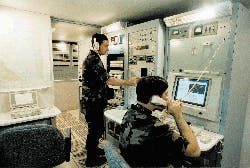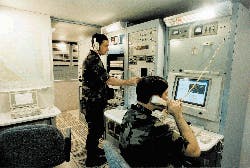Northrop COTS computer processes U-2 radar images during Balkans War
By John McHale
BALTIMORE — Commercial off-the-shelf (COTS) technology enabled NATO commanders to receive real-time synthetic aperture radar (SAR) imagery from the U-2 reconnaissance aircraft during the recent Balkans War in Kosovo and Serbia. The information regarding enemy locations helped commanders plan fighter missions.
U.S. Army field commanders accessed the U-2 imagery with Baltimore-based Northrop Grumman Electronic Sensors and Systems Common Imagery Processor (CIP) and Enhanced Tactical Radar Correlator (ETRAC), the ground station that receives and screens the U-2 imagery.
CIP, which is the U.S. Department of Defense/National Imagery and Mapping Agency standard for all tactical imagery-processing systems, provides battle commanders with supercomputer power in a compact design that gets them intelligence data directly from aircraft.
The CIP in Kosovo "went about 63 or 64 days, 24 hours a day, without a failure," claims Bill Irby, program manager for CIP at Northrop Grumman. A failure, he explains, would be any hardware or software glitch that required a long recovery time.
The CIP receives video from the aircraft via a tactical data link, then it processes the data, changing it into National Imagery Transmission Format, which it then sends in real-time to displays in the ETRAC, Irby explains.
Several different sources can receive the imagery not only for reconnaissance, but also for deep-attack, and real-time-point-and-click target positioning for tactical dissemination and communication.
Once he starts using the ETRAC display, a mission command imagery analyst screens the data, then forwards it to battlefield commanders for mission planning, he adds.
The ETRAC`s features include day/night imaging, SAR, infrared (IR), electro-optical (EO) processing, and remote workstation capability. Barco Display Systems in Tucker, Ga., provides the station`s displays. The CIP enables multi-service common access to SAR, IR, and EO imagery sensors that fly on the U-2, as well as on and medium- and high-altitude unmanned aerial vehicles.
The CIP also uses two I/O boards from Myriad Logic in Silver Spring, Md. — the CDL-2740 which synchronizes the common data link and stores the resulting formatted data in VME or Raceway memory; and a common data link router, the CDL-2745, which is a VME module capable of receiving high- or low-rate serial data from four external sources.
Northrop engineers also tested the CIP with APG-73 SAR and EO and IR sensors aboard the U.S. Navy F/A-18 jet fighter-bomber, Irby says.
Current efforts center on retrofitting CIP into major ground stations serving Army, Navy, Air Force, and Marine Corps tactical commanders, who will have access to imagery from the U-2, F/A-18, and Global Hawk unmanned aerial vehicle from Teledyne Ryan in San Diego. In about two years CIP will process video for the Predator UAV from General Atomics in San Diego, Irby says.
The Enhanced Tactical Radar Correlator from Northrop Grumman Electronic Sensors and Systems received and screened U-2 imagery processed by Northrop`s Common Imagery Processor during NATO`s war in the Balkans.

